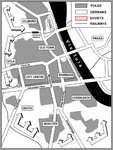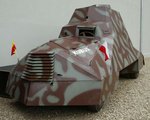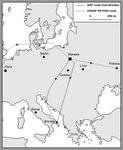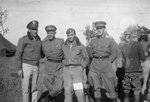There were many different opinions on whether the "Burza" should take place in Warsaw because of the experiences from the East and fears that a combat would cause the destruction of the city and losses among the civil population,. Eventually, it was decided that the battle of Warsaw would not be only of military significance but also of political one. The emotional tension among the citizens and a hearty will to fight expressed by the AK soldiers were also taken into consideration. Finally the decision about starting the uprising in Warsaw was made (with participation of the Government Delegate Home and the head of RJN) on July 31, when the advancing Red Army units were coming close to the city district of Praga, lying on the eastern bank of the Vistula River. Some 23 000 of the AK soldiers started the uprising in the afternoon of August 1, 1944, under the Warsaw Region Commanding Officer, colonel Antoni Chruściel (aka "Monter"). Although during the first few days of combat the insurgents captured a lot of strategic objects, and as the days went by the ranks were increasing (together there fought some 34 thousands of soldiers), the Home Army was unable to fully drive the Germans out of the downtown, nor to seize the main communication routes and bridges. The 16-thousand-strong German garrison was significantly reinforced (including the troops specializing in fighting partisans) and on August 5, 1944, the Germans began to counter-strike, using tanks, heavy artillery and assault aircraft. In the first of recaptured districts (Wola), the German troops committed a mass slaughter of civilians. This was to happen again later a few more times. The attacking German columns split Warsaw into the "insurgent islands", the contact between which was managed by secret passages through cellars and sewers. In these areas the authority was taken over by Polish administration, newspapers were published, a radio station broadcast ("Błyskawica", or the "Lightning"), municipal services worked.
It was expected that the battle would last a few more days, until the Red Army entered the city. Despite many pleas, including the ones from the Polish prime-minister who was paying a visit in Moscow since July 31, sometime before August 8, Stalin ordered to delay offensive actions nearby Warsaw. He did not even agree for the allied transport airplanes to land on Soviet airfields which practically precluded helping the uprising by airdropping the supplies, because the nearest airfields were located in England and Italy. Not till the middle of September, when the uprising was already on the verge of disaster, a mass air-drop was possible but the insurgents took over only some 47 tons of it. The battle dragged on, the death toll among the civilians increased, there lacked food, water and medicines. Capturing Praga by the Red Army and unsuccessful attempts of the Polish troops commanded by General Berling to establish a bridge-head in the left-bank Warsaw did not change the situation. On October 2, 1944, the insurgents capitulated. Some 150 000 civilians were killed, most of the city was utterly ruined (later on special German squads kept destroying the remaining buildings), 520 000 citizens expelled of the city. 17 000 insurgents were taken prisoners.
The Warsaw Uprising was the greatest battle fought by the Polish army in WW2: 10 000 soldiers were killed, 7 000 more were missing in action. Major losses were inflicted to Germans – 10 000 killed, 6 000 MIA, 300 tanks, guns and armored vehicles lost.
The uprising did not reach its military nor political objectives, yet for the generations of Poles to come it became a symbol of courage and determination in the struggle for independence
It was expected that the battle would last a few more days, until the Red Army entered the city. Despite many pleas, including the ones from the Polish prime-minister who was paying a visit in Moscow since July 31, sometime before August 8, Stalin ordered to delay offensive actions nearby Warsaw. He did not even agree for the allied transport airplanes to land on Soviet airfields which practically precluded helping the uprising by airdropping the supplies, because the nearest airfields were located in England and Italy. Not till the middle of September, when the uprising was already on the verge of disaster, a mass air-drop was possible but the insurgents took over only some 47 tons of it. The battle dragged on, the death toll among the civilians increased, there lacked food, water and medicines. Capturing Praga by the Red Army and unsuccessful attempts of the Polish troops commanded by General Berling to establish a bridge-head in the left-bank Warsaw did not change the situation. On October 2, 1944, the insurgents capitulated. Some 150 000 civilians were killed, most of the city was utterly ruined (later on special German squads kept destroying the remaining buildings), 520 000 citizens expelled of the city. 17 000 insurgents were taken prisoners.
The Warsaw Uprising was the greatest battle fought by the Polish army in WW2: 10 000 soldiers were killed, 7 000 more were missing in action. Major losses were inflicted to Germans – 10 000 killed, 6 000 MIA, 300 tanks, guns and armored vehicles lost.
The uprising did not reach its military nor political objectives, yet for the generations of Poles to come it became a symbol of courage and determination in the struggle for independence







![355fg Shuttle 100BG supply drop_18sep1944 [hovde].jpg](/forum/data/attachments/92/92874-e1c84880e2766e5f13833a7defbc8276.jpg)
![355fg Shuttle Mission_18sep1944 [hovde and marshall].jpg](/forum/data/attachments/92/92873-3911a5ca2265e16ce465e87d22ae4730.jpg)
![354 Marshall and Sims_Shuttle Mission [marshall].jpg](/forum/data/attachments/92/92872-0cb2a863a4ac9c3e24c9b9978016d39d.jpg)
![355fg Shuttle Mission Map_scrubbed 15sep1944 [marshall].jpg](/forum/data/attachments/92/92871-554c7d14f4581f4f0aa818201798dd87.jpg)
![354 Shuttle_Henry Brown [marshall].jpg](/forum/data/attachments/92/92876-737497e188e785830463faf149047d74.jpg)
![355fg Shuttle_354 pilots [marshall].jpg](/forum/data/attachments/92/92877-39db1a5133ae91c2571a258a50cab8b8.jpg)
![355fg Shuttle 100BG east Warsaw_18sep1944 [hovde].jpg](/forum/data/attachments/92/92878-3db88cbebe64e30c3099bb857cbce3c0.jpg)
![355fg Shuttle 100BG Warsaw_18sep1944 [hovde].jpg](/forum/data/attachments/92/92879-8c30d443cf5c1fb602fa4f5c7292be3d.jpg)